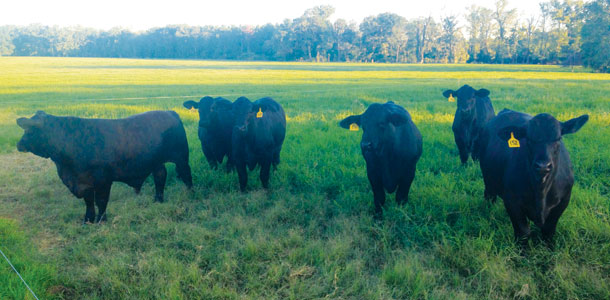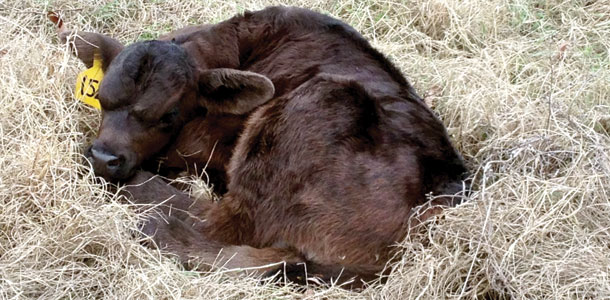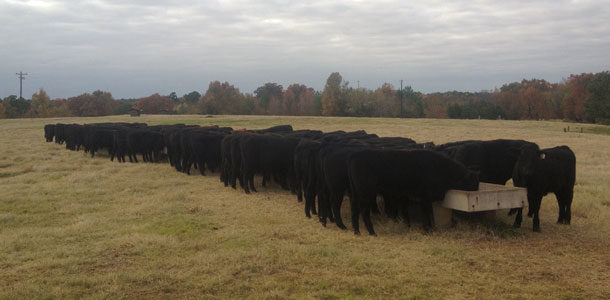Carlos Griffin ranches in the Piney Woods area of eastern Texas on land that has been in the family several generations. “This area grew a lot of cotton and corn in the early days. Our place was started in 1849, and our family has lived here continuously. Up until World War II, no one grew anything but cotton and corn. After the war, all the farm workers left and went north to work in the factories.
We had fallow fields, not growing anything, so people started growing crimson clover for seed,” says Griffin.
Clover improved the soil fertility and many other plants started growing. “This is what put us in the beef business. We started growing it for seed and now it’s just a crop we intermingle with bermudagrass.
The clover comes on strong in the spring and then dies early but provides nitrogen and helps with forage growth,” he says.
“The most exciting thing we’ve begun to use in the past few years is Tifton 85. It’s a hybrid bermuda and a phenomenal grass. It responds well to water and fertility and is very drought-tolerant. It really helps us.
We run about 150 head in a cow-calf operation and also background some calves. We feed out a few cattle for customers but primarily sell feeder calves after they are backgrounded, selling them at 650 to 700 pounds,” says Griffin.
The market for natural beef is improving. “We plan to keep more heifers this year to replenish the herd. Some of the cows are getting old. We also had a terrible drought in 2011, and this past year it was also bad up until September. Then it started raining – a welcome change,” adds Griffin.
“We cut and bale about 200 acres for hay and sell some hay. Most of it we put in the barn, and whatever we don’t have room for (and store outside), we try to either sell or feed it first,” he says.
He’s now using the Tifton 85 for much of the hay and pasture. “We have some irrigation wells, and this grass responds very well to irrigation in summer. We can cut it about every four to five weeks.
For pasture, we limit-graze, but most of it we cut for hay. Late in the summer, we grow some back for the cattle to graze into the fall,” he says.
“We also have a small acreage of alfalfa; we are one of the few places in eastern Texas that can grow alfalfa. We’ve been playing with that for several years and feeding it to some of our young stock,” he says.
“The last couple of years we’ve been working with haylage – alfalfa and grass. We were amazed at how well the cattle like it; they eat every bit. We don’t feed any protein supplement like cubes but on occasion have used the tubs.
Most of our cattle do just fine on the hay we grow. The alfalfa has enough protein, and most of the Tifton grass is around 12 percent protein or better. This is very adequate for a dry cow,” says Griffin.
“A lot of our grass has clover in it, and the cattle graze this during winter, which provides enough protein. Our winters are not very cold; a cold day here would be in the upper 20s. Occasionally it will be colder, but a cold spell doesn’t last very long.”
The growing season ends in October or early November, and the ryegrass starts growing again in late February. Winter is fairly short. “Once the cattle start grazing in the spring, they won’t eat hay.
Summer can get pretty hot, and on a place where there’s no irrigation, the grass will stop growing during the heat. We have a limited amount of irrigation, and we try to use that water for the hay. The cattle can keep grazing through summer, however; we simply rotate them through the pastures,” he explains.
“We start calving in February and try to be done by early April so the cows can breed back during the spring growth and before hot weather. We have mostly Angus cattle, and they don’t like heat; they don’t do as well in the heat as Brahman cattle.
We have some mixtures with Brangus, and they do much better in the heat and also have a little more growth due to heterosis,” he says.
“Our family transitioned into the cattle business in the late 1940s. We went from row crop into pasture at that time. Now with the fast-growing Tifton grass, we let the backgrounding calves go through the pastures first and then follow them with cows.
Most of that grass we cut for hay, but some areas we use for calf grazing,” he says.
“The fast-growing Tifton has really changed the way we do business. We have more hay to sell, as well as more pasture. We also have whitetail deer and some hunting leases.
We have a lot of pine and other timber on the steeper hillsides of our ranch and harvest it as well. Everything is managed around the pastures, however. We have about 2,000 acres and a lot of it is in timber,” says Griffin.
“We fight some weeds in summer; we spray on a limited basis very early in the season. We have to be careful what we spray because we don’t want anything to carry over and affect the growth of our clover in wintertime,” he explains.
Family
Griffin and his wife, Margaret, (MiMi) have a son who is becoming more involved with the ranch. “We raised three boys. We lost the middle one, but the other two help on the ranch.
The youngest one will eventually take over and keep things going. My wife MiMi and I just celebrated our 60th wedding anniversary, so we hope to pass this ranch on to the next generations.
Our oldest son (Carlos Jr.) we call Scooter. He’s been in the oil business and has done well. Everyone has a nickname. They call me Pappy. We have eight grandkids and nine great-grandkids,” says Griffin.
“Our youngest son, Paul, has a degree in mining engineering, and he’s applying that knowledge to the irrigation. He’s become an expert on irrigation systems. Paul has one son who helps on the ranch and two daughters who help on occasion. They live in Dallas and Austin,” he says.
“We just hope to keep on going, and keep raising cattle. I am primarily interested in the grass-growing part of it. I got a degree in agronomy many years ago at Texas A&M.
Our whole family are Aggies; all three boys graduated from Texas A&M and six of our granddaughters graduated from A&M,” says Griffin. FG
Heather Smith Thomas is a freelance writer based in Idaho.
PHOTOS
Photo 1: The 2013 Brangus calf crop is backgrounded with a 3-pound to 4-pound daily supplement in preparation for selling them as 650-700-pound feeder calves.
Photo 2: Brangus 2-year-old bred heifers begin calving in February 2014 at Griffin’s ranch. Griffin will keep more heifers this year to rebuild his herd.
Photo 3: This Brangus calf #152 was born in the early spring of 2013 and will be weaned to graze on Tifton 85 pasture in eastern Texas.










